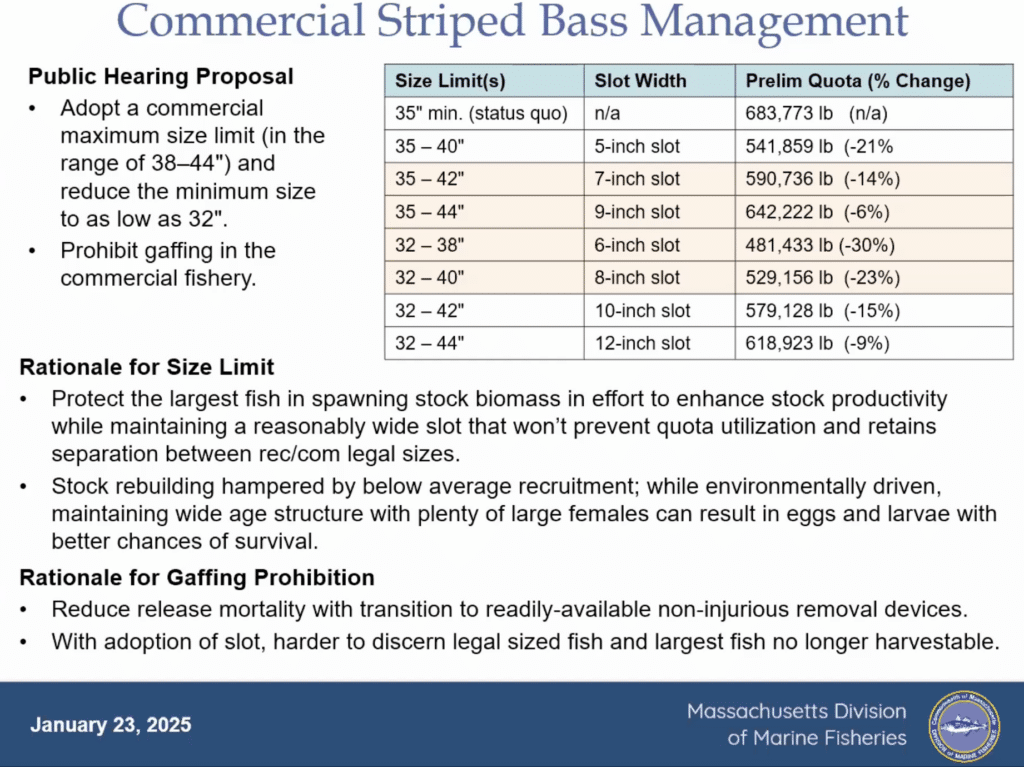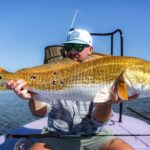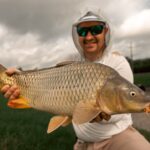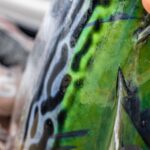
Striped Bass Addendum III: Wasted Resources & Meandering Towards Moratorium
Header Photo: Camden Spear Over the past several years, ASGA has consistently championed science-based, precautionary
The Massachusetts Division of Marine Fisheries (DMF) is leading the way with a conservation-minded proposal aimed at safeguarding the largest spawning fish in our coastwide striped bass fishery. This action could not only protect critical cohorts of the stock but also mark a paradigm shift in management priorities along the coast. Now currently in the crosshairs of Massachusetts’ commercial striper fishery, our large, fecund female stripers can produce more and larger eggs, as well as spawn earlier than smaller fish. This morning at a Marine Fisheries Advisory Commission Business Meeting, DMF’s Nichola Meserve presented a plan to address the pressing need to rebuild the coastwide stock through conservation-focused action. This plan does so while still balancing the needs of the commercial fishing industry. Here’s what you need to know about the proposal and what it means for the future of striped bass management:
DMF has proposed adopting a commercial slot limit that would cap the maximum harvest size somewhere between 38–44 inches, while potentially reducing the minimum size to as low as 32 inches. This marks a significant departure from the long-standing minimum size of 35 inches with no maximum, a frequent complaint of conservation-minded anglers who can’t fathom harvesting our largest, most productive fish.

The rationale behind this shift is focused on spawning production: larger females contribute disproportionately to the spawning stock biomass (SSB). By protecting these critical spawners, the DMF aims to enhance stock productivity and stability. This is even more critical while we face six straight years of abysmal spawning production. Studies show that larger females produce more robust eggs and larvae, improving survival rates. As we have talked about in past blogs and podcasts, striped bass spawn in waves, so regulations that help maintain a wide age structure in the population can increase the likelihood of spawning success amidst varying climate factors.
In line with the proposed slot limit, DMF has also recommended prohibiting gaffing in the commercial fishery. The use of gaffs is already a hot topic for a majority-release species like striped bass. It has been allowed in the previous years due to no maximum size limit (with no upper limit, there is less error for “eyeballing size” when sticking a fish next to the boat). With a slot limit implemented, this is no longer appropriate or feasible.
In the brief discussion of this proposal, DMF also mentioned the future implementation of the “pinched tail method” for measuring commercially harvested fish to standardize measurement across sectors. This change would ensure consistency and prevent discrepancies in determining whether fish on the upper end of the slot limit are appropriately judged for harvest. Fish that are “a tick” above the maximum size will be able to breathe a sigh of relief.
The Massachusetts commercial striped bass fishery currently harvests more large females than any other state’s commercial fishery. Protecting these spawners is crucial for rebuilding the stock, which has faced six consecutive years of below-average recruitment from the Chesapeake Bay—the primary nursery for striped bass. Poor recruitment has also been observed in other smaller spawning tributaries further up the coast.
The proposed measures reflect an understanding that rebuilding striped bass requires maintaining a wide age structure. Larger, older females produce larger and higher-quality eggs that yield larvae better equipped to survive environmental challenges such as changes in salinity, water temperature, and prey availability.
Mass DMF will present this proposal at an upcoming public hearing in late winter, providing an opportunity for stakeholders to provide public comment. As always, ASGA will keep our community informed on opportunities to utilize their voice. Our Association applauds Massachusetts for being a leader in striped bass conservation. This proposal reflects the growing recognition that we are teetering on the edge with this coastwide stock. Responsible management must prioritize the long-term health of the fishery over short-term gains. Protecting the largest spawners, reducing release mortality, and standardizing measurement methods are all measures that can make a meaningful difference in the effort to rebuild striped bass stocks. ASGA encourages all stakeholders to participate in the public comment process and support science-based management that ensures the future of this iconic fishery.
Stay tuned for updates from this issue in Massachusetts, along with potential moves that states are making for the 2025 season. ASGA will continue to advocate for policies that prioritize the sustainability of striped bass and the communities that depend on them. This proposal from Massachusetts is what leadership in conservation looks like. We consistently say that Massachusetts DMF sets the bar for other state agencies, and this is simply another example.

Header Photo: Camden Spear Over the past several years, ASGA has consistently championed science-based, precautionary

Photo Credit: Carter Abramson | Trevor Johnson Every now and then, we encounter something so

This past weekend, ASGA proudly sponsored the Dirty Carp Tournament in Louisiana — and no, you didn’t misread that.

After years of data pouring in from The Albie Project, advocacy, persistence, and support from
We rely on our members and donations to keep fighting for a sustainable tomorrow in marine conservation.
GIVE THE GIFT OF FISHERIES CONSERVATION THIS HOLIDAY SEASON. SHOP ASGA GOODS THAT FUND FISHERIES RESEARCH & ADVOCACY CAMPAIGNS
JOIN ASGA IN CALLING FOR CRITICAL MANAGEMENT ACTION AFTER YEARS OF SPAWN FAILURES & POOR MANAGEMENT.
By using this website, you agree to our use of cookies. We use cookies to provide you with a great experience and to help our website run effectively. To learn more, please review our privacy policy.
5 Responses
Yea so all the 45lbers we catch are all dead anyway and don’t count toward the quota. YAY. Even thought the recreational fisherman are the problem. Clowns
You’re operating on false assumptions. 100% of commercially harvest fish die. Only a percentage of those released do. The net gain for the population of incredibly fecund females we need to get spawning back on track is significant. Be careful with comparisons of Rec v. Comm. You won’t like what the economics show. Respectfully, the clowns committed to long term sustainability of this fishery.
Hey Trev – can you cite your sources for the stat about all the 45lbs dying?
Psst – guess what gang trev isnt gonna be able to cite a source, he’ll probably saying something like “uhhh, it’s just common sense…” which the new cop-out phrase for people who don’t know what they’re talking about.
I attended the public hearing on these commercial proposals held by the DMF at Massachusetts Maritime Academy.
To put it succinctly, the commercial crowd did not understand why the DMF would propose slot limits or any decrease in harvest if they weren’t asked to do so. Overall, the sentiment is that they have been targeted for unfair reductions as it is and there should be no changes. I believe the DMF leadership appeared a little taken aback by the commercials antipathy to any reduction in quota or conservation consideration. When the DMF suggested that a slot limit would put fish in a bank for future harvest, the response was – and I’m paraphrasing – why put them for safe keeping when nobody knows whether they will be there in the future, so let’s just harvest them now.”
The DMF also proposed banning gaffs in the commercial fishery, which has already be done in the recreational sector. This, too, met with absolute disapproval, with my favorite argument being that since commercials are such great fishermen and have been so many bass, they can tell with absolute certainly whether a striper is of legal length. That’s something I think would be fun to test by having some of them on my and let them guess at the length of fish they caught without removing them from the water and see how close they come to the actual length.
And then there was the concern that a rocking boat would make it dangerous to bring a fish on board, something that gaffing would protect these big, tough recremercial anglers from any harm.
Stop commercial bass fishing once and for all. Dmf has their heads up the commercial fisheries ass. Of course they will never admit that they are the problem. You simply must stop killing the breed stock for the stripers to survive.
Dmf needs a giant DOGE